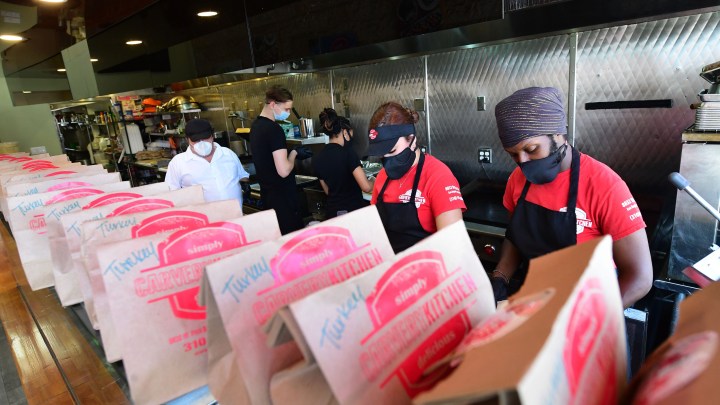
Unions are gaining momentum at restaurants. They’ve been here before.
Unions are gaining momentum at restaurants. They’ve been here before.

Updated Sept. 28, 2021
The food-and-beverage industry has one of the lowest unionization rates in the U.S. — 3.4% of workers last year, compared to the overall rate of nearly 10.8%. But workers from some high-profile shops hope to narrow that gap and have tried to organize at San Francisco’s Anchor Brewing; Voodoo Doughnut in Portland, Oregon; and, most recently, a group of Starbucks workers in Buffalo, New York.
While it may seem like a new movement, organized labor in the industry goes all the way back to 1891, when the first restaurant union — now called Unite Here — was started.
“It was a different world, especially when we got into the early 20th century,” said David Whitford, a historian at Unite Here.
Back when American manufacturing was strong, so were manufacturing unions. And that had a trickle-down effect.
“If you owned a bar or restaurant in a little town in the Midwest where there was some kind of union factory, and you wanted the union workers to come patronize your establishment, then you needed to be a union restaurant also,” Whitford said.
Communities would stage “sip-ins” at nonunion restaurants, with activists lingering over a single cup of coffee as an act of protest. Unionized bars and restaurants hung signs in their windows like badges of honor. Customers saw those signs as signals that the quality would be higher.
“So, there was a sense that if you had a union cook, you were going to have better food. If you had a union server, you were going to have better service,” said Dorothy Sue Cobble, the author of “Dishing It Out: Waitresses and Their Unions in the Twentieth Century.”
Food-service unions were so common that membership was portable. Workers took their benefits with them from job to job. Unions didn’t just benefit workers, either. Employers turned to unions for hiring, human resources issues and even scheduling when someone called in sick.
By the 1950s, nearly one-third of private-sector workers belonged to a union. But, remember how more restaurant workers unionized as manufacturing grew? The opposite was also true.
When manufacturing declined, so did restaurant unionization. Labor laws written in the 1930s were mostly created to protect factory workers, Cobble said. And on the flip side, “there were also provisions in these laws that made it harder for nonfactory workers to organize, particularly small sectors where there are small employers and high turnover.”
Meanwhile, the restaurant industry was changing dramatically. Chains with the money and power to fight organizing became neighborhood staples, and cheap fast food proliferated. Unionization rates at restaurants dropped. Wages fell and benefits mostly disappeared.
In recent years, though, momentum to organize has grown. Public support for unions is at the highest level in almost two decades, with two-thirds of Americans approving of them, according to a recent Gallup poll.
Cobble thinks the pandemic could push the trend even further. “There’s been enormous stress on front-line and service workers, so there’s a real desire for change,” she said.
The Midwestern chain Colectivo Coffee recently became the largest coffee shop company in the U.S. to unionize, with about 450 eligible employees.
“I think that the momentum really did grow with COVID, like people saying, ‘This has been an issue for a while, but this just shone a light on it,'” said Zoe Muellner, one of the organizers.
It wasn’t easy and took years because workers had to coordinate across 20 locations and deal with employee turnover. The union won by seven votes. Since Colectivo workers unionized, Muellner said, other coffee shop workers around the country have been calling to get advice on how to do the same.
“You keep hearing things like, ‘Oh well, this is just the service industry. If you don’t want things to be like this, get a different job.’ And so I think that’s something now people are seeing: ‘Oh, there’s a lot less people willing to work in the service industry. They are getting different jobs,'” she said.
There’s a lot happening in the world. Through it all, Marketplace is here for you.
You rely on Marketplace to break down the world’s events and tell you how it affects you in a fact-based, approachable way. We rely on your financial support to keep making that possible.
Your donation today powers the independent journalism that you rely on. For just $5/month, you can help sustain Marketplace so we can keep reporting on the things that matter to you.











